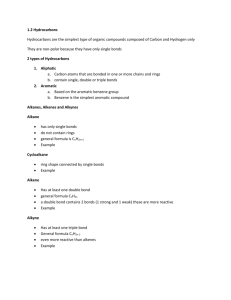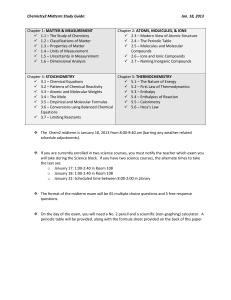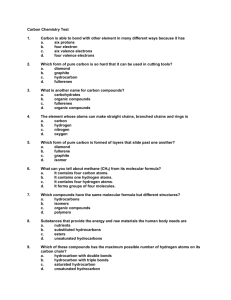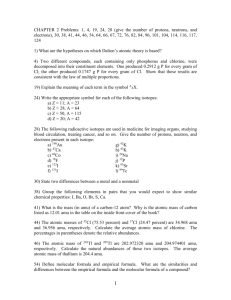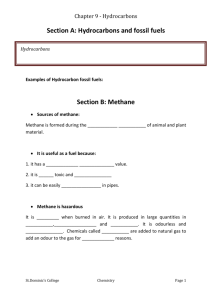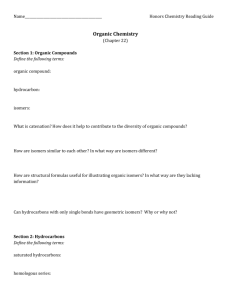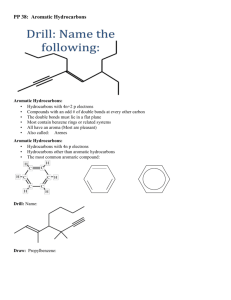Informal Glossary document
advertisement
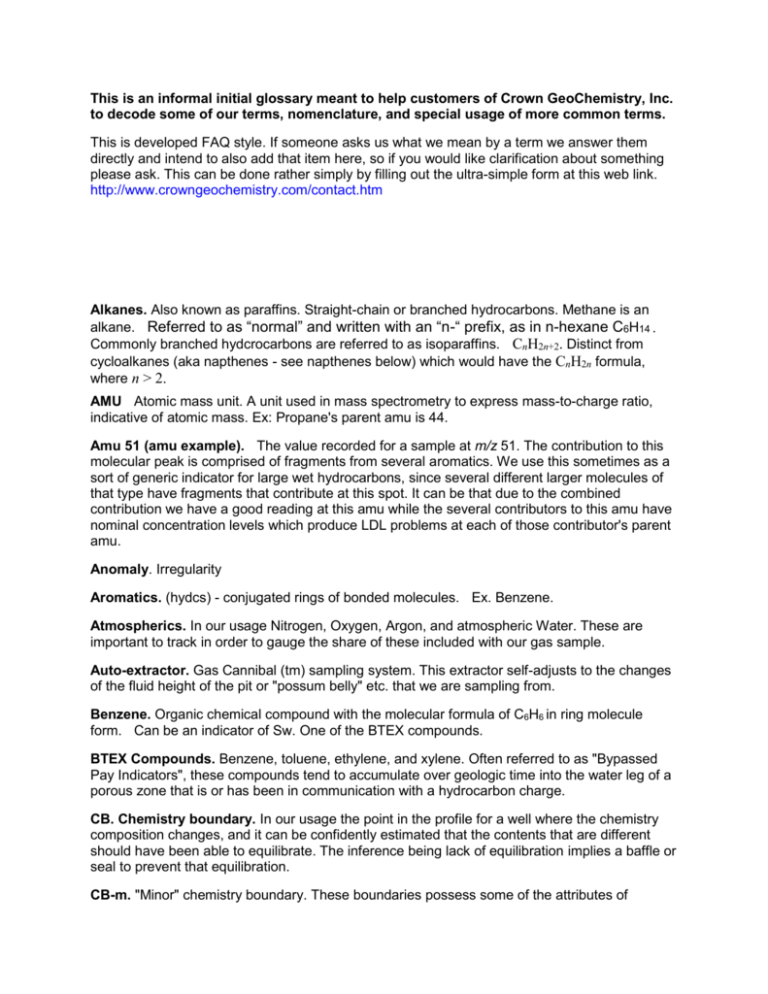
This is an informal initial glossary meant to help customers of Crown GeoChemistry, Inc. to decode some of our terms, nomenclature, and special usage of more common terms. This is developed FAQ style. If someone asks us what we mean by a term we answer them directly and intend to also add that item here, so if you would like clarification about something please ask. This can be done rather simply by filling out the ultra-simple form at this web link. http://www.crowngeochemistry.com/contact.htm Alkanes. Also known as paraffins. Straight-chain or branched hydrocarbons. Methane is an alkane. Referred to as “normal” and written with an “n-“ prefix, as in n-hexane C6H14 . Commonly branched hydcrocarbons are referred to as isoparaffins. CnH2n+2. Distinct from cycloalkanes (aka napthenes - see napthenes below) which would have the CnH2n formula, where n > 2. AMU Atomic mass unit. A unit used in mass spectrometry to express mass-to-charge ratio, indicative of atomic mass. Ex: Propane's parent amu is 44. Amu 51 (amu example). The value recorded for a sample at m/z 51. The contribution to this molecular peak is comprised of fragments from several aromatics. We use this sometimes as a sort of generic indicator for large wet hydrocarbons, since several different larger molecules of that type have fragments that contribute at this spot. It can be that due to the combined contribution we have a good reading at this amu while the several contributors to this amu have nominal concentration levels which produce LDL problems at each of those contributor's parent amu. Anomaly. Irregularity Aromatics. (hydcs) - conjugated rings of bonded molecules. Ex. Benzene. Atmospherics. In our usage Nitrogen, Oxygen, Argon, and atmospheric Water. These are important to track in order to gauge the share of these included with our gas sample. Auto-extractor. Gas Cannibal (tm) sampling system. This extractor self-adjusts to the changes of the fluid height of the pit or "possum belly" etc. that we are sampling from. Benzene. Organic chemical compound with the molecular formula of C6H6 in ring molecule form. Can be an indicator of Sw. One of the BTEX compounds. BTEX Compounds. Benzene, toluene, ethylene, and xylene. Often referred to as "Bypassed Pay Indicators", these compounds tend to accumulate over geologic time into the water leg of a porous zone that is or has been in communication with a hydrocarbon charge. CB. Chemistry boundary. In our usage the point in the profile for a well where the chemistry composition changes, and it can be confidently estimated that the contents that are different should have been able to equilibrate. The inference being lack of equilibration implies a baffle or seal to prevent that equilibration. CB-m. "Minor" chemistry boundary. These boundaries possess some of the attributes of boundary but not all. We like t o have more than one parameter type to suggest a boundary. If there is evidence to support a boundary, but not a second or third line of evidence to support the decision then we may elect to indicate a minor boundary. Compartmentalization. A way a defining communicated portions of a well, in our usage according to the distinct chemical composition of each section. Stratigraphic causes, sections defined by perm-related seals, and fault block isolation are among the causes of gas phase compartmental isolation. Component Gas. In our usage generally the C1-C10 normal hydrocarbons which we display as curve data in a track comparable to the curve data track usually given that name in old-fashioned mud logs. Crossplot. In our usage an x-y scatter chart which plots one chemistry on the "Y" axis and another chemistry on the "X" axis of that chart, with the data points colour-coded to indicate depth ranges. Generally these charts would have the lighter molecular weight species on the "Y" axis. Where rig depth is used on an axis that is usually the "Y" axis, creating a typical measured depth vs. species chart. Diesel Baseline. Oil Base Mud is usually comprised of mud additives in a diesel fluid system. Diesel fragments contribute a bit at C3 and significantly to the m/z spots for C5 and particularly at C7. The diesel-derived trash on the C7 line lifts that value artificially high and can cause the C7 to register at or near the C5 trace. We refer to this anomaly as the "Diesel Baseline" and in constant mud sample conditions this C7 curve will vary through a relatively small range due to the volume of the diesel supply relative to a geologic volume. Fingerprint. In our usage the identifiable components (e.g. an unusual part of the well) that distinguish one portion of a well from other parts of the well or from other wells in a field, etc. Fluid contact. Standard oil/gas/water contact. We can indicate for these with varying confidence depending on the signal for our indices in a particular well. . Fractionate. In general geo-chemistry would refer to the process whereby there is separation of one product or species from another. In more general usage the term would likely occur in describing the indications of such fractionation, i.e. "methane/propane fractionates lighter at this CB" indicating perhaps for the methane to be at a higher ratio for the portion after the CB in a crossplot which included methane and propane with part of the investigation range before and part after a CB. GC. Gas Chromatograph. In old-fashioned mudlogging these vary in quality over a wide range. They typically take a measured dose of sample and attempt to sort this sample so that components of the sample would be measured individually. The process in the field generally takes exceptional shortcuts to the accepted lab practices for this equipment, and thereby produce actual results almost universally inferior to perceived results. Headspace gas. Casually - the gas contained in a trap above a sample. A vapour sample. Essentially gas sample used in typical oilfield applications is a form of headspace gas. Heavy hydrocarbons. In our usage C6 and heavier. HC. Abbreviation for hydrocarbon(s). Hydc(s). Informal abbreviation for hydrocarbon(s). Hydrocarbons. Organic compounds consisting entirely of carbon and hydrogen. Lag time. The time it takes the drilling mud, which carries gas sample and well cuttings, to circulate from the bottom of the well, up the well, and across the sample collection points. LAN. Local Area Network Light hydrocarbons. C1 to C3 Lower Discovery Limit. or LDL. Refers to the concentration level below which the instrument cannot detect or isolate. Our LDL varies from a few parts per million to tens of parts per billion, depending on the relative activity at any given m/z. Spectrograph. A graph showing the peaks for each m/z for a given sample. MD. Measured depth. Spots the apparent depth for a lateral well, basically by pretending the well is a vertical hole. Compared with TVD, which is true vertical depth. If a hole turns lateral at 5,000' and then drills sideways for 3,000' it would have 8,000' as the MD for the last foot, despite that the actual depth for that hole is still about 5,000' below surface. Mid-range hydrocarbons. – C4, C5 MS. Mass Spectrometer. We use a portable quadrupole mass spec developed by Fluid Inclusions Technologies, Inc. (tm) which is known as the DQ1000 (tm). Mudgas. Gas that is sampled from the drilling fluid or "mud". MZ. i.e. m/z 22. Ratio of mass to charge. The mass spec actually records m/z. This is approximately equivalent to the amu (molecular weight) of the species. Exceptions exist, for instance in the case of CO2 and ++CO2 (double charged CO2) both would have actual amu at 44, but ++CO2 would have double the charge and end up with half the mass to charge ratio at m/z 22. Naphthenes. Cycloalkanes, which are types of alkanes that have one or more rings of carbon atoms in the chemical structure of their molecules. Normalized. Here, using a relationship between data sets which is designed to reduce volume discontinuity of the data set. OBM. Oil-based mud Organic acids. Organic compounds with acidic properties. Overpressure. Geologic pressure above the normal gradient , which can be indicated by a relative increase in CO2 in say a monotonous carbonate sequence. Paraffin ratios. Here light, mid-range, and heavy hydrocarbons as ratio to each other. These include R1 – C3/C1, R2 - C5/C3, R3- C7/C3 Paraffin. Common name for the alkane (straight-chain) hydrocarbons. See alkane above. Generally refers to larger hydrocarbons. Permeability. A measure of the ability of rock to allow the flow of fluids . Porosity. Ratio of the volume of openings (voids) to the total volume of material. This represents part of the storage capacity for the geologic material. Porous zones. Zones with higher porosity than the general section. PPM. Parts per million. A unit range to express very dilute concentrations of substances. Just as percent means out of a hundred, so parts per million or ppm means out of a million. Primary porosity. The main or original porosity system in a rock. Proximity to pay. The nearness laterally from this spot to the pay-containing portion of this same zone of the rock, for example if this well drilled down dip from pay and encountered water instead, with hydc pay present for this same zone 1 mile away Reproducibility. The term is commonly used as a description of the ability of an investigation technique like ours to consistently deliver about the same indication for about the same underlying condition through repeated trials. ROP. Rate of penetration - measured as minutes per foot (mpf) or feet per hour (fph). Secondary porosity. A porosity system other than the primary system, enhancing the overall porosity of a rock. This can be a result of chemical leeching of minerals or the generation of a fracture system, among other causes. Sol 1. Quantity of one of the hydrocarbon solvent components of acetic acid Sol 2. Quantity of benzene Sol 3. Quantity of toluene Sol 5. benzene / C6 Standardized data. Statistically derived data norming, in our most common usage this is done with standard deviations, transforming raw numbers for a data set (such as all the methane values for a particular well) so that the center is at the mean (zero std dev), and with 99.5% of the population falling within plus/minus 3 standard deviations. Sulfs. (I.e. Sulf1) In our usage these curves indicate the presence of fragments related to the sulfide or sulfate compounds listed below. Sulf1. H2S Reminder - this is peak has heavy interference due to oxygen at the same m/z and therefore the actual test would require removal for the contribution estimated to be caused by oxygen. This is therefore not a worthwhile safety tool for H2S detection, but may be used in some cases in conjunction with other logic to help determine more significant H2S variability. Sulf2. SO Sulf3. SO2 Sulf4. CS2 Sw. Saturation of water, (H2O). The portion of the fluid phase that is water. Sw indicators in our data are generally indexed together and the Sw change is inferred from relative change in the index. TG. Total Gas. In old-fashioned thermal and catalytic detectors would be the signal for a metered portion of the well sample. This portion is measured by the detector without a presort using the simple chromatograph system they also employ. Our duplicate of this concept is a curve comprised of C1+C2+C3+C4+C5. TGD. Total Gas Detector Tight. Opposite of porous. Rock with very low permeability. Toluene. One of the BTEX compounds - like benzene. It can be used to help indicate Sw (H2O wet) because of its relative concentration and solubility in water. TVD. True vertical depth. See explanation of MD above. Volatile organic compounds. Organic chemical compounds that have high enough vapor pressures under normal conditions to significantly vaporize and enter the atmosphere. WITS. Wellsite Information Transfer Standard. Rig service companies use this data format, or one of several modern versions of it, to exchange information from one company or computer to another. We need the service company that is contracted to provide drilling parameter info at the well to make this data available to us in this format. This company is typically Totco or Pason, but there are many of these companies, and they give us a "wits link". Xylene. Refers to any of three aromatic hydrocarbon isomers, essentially benzene plus two methyl groups.

